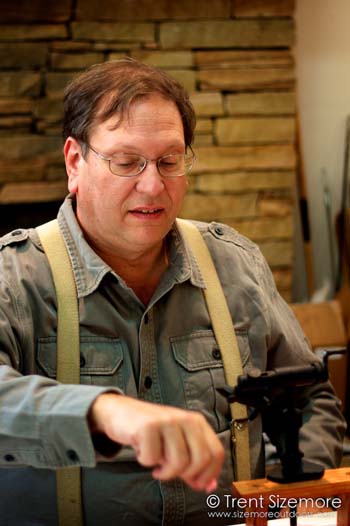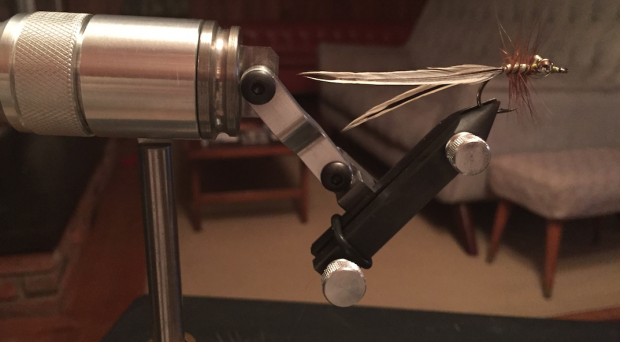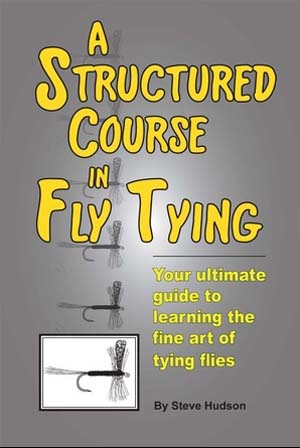Beginner Fly Tying by Steve Hudson, Editor-At-Large
I’m glad you’ve decided to learn to tie flies! It’s fun! But before you can begin, you’ll need a few essential tools – and that’s what we’ll look at in the next few installments of this series.
Your biggest tying-related purchase will be a fly tying vise
[dropcap]A[/dropcap]s you shop for a vise, you’ll quickly discover that there are many designs to consider. Some are simple; others are complex. They mount on your desk in different ways, and they use different ways to hold the hook. And of course there’s the matter of cost – some are inexpensive, while others cost hundreds of dollars.

Photo credit Terry Sizemore. Steve Hudson tying patterns at the famous Unicoi Outfitters in north Georgia. Steve patterns and tying techniques are embraced throughout the Southeastern U. S.
The first choice is clamp-mount vs. pedestal-mount
Clamp-mount vises mount on the edge of a table or other support via a C-style clamp. The vertical mast of the vise is then secured in the clamp mount. You can use these vises anywhere there’s a suitable edge for mounting the clamp, and the vise will be as stable as the edge to which it is secured.
If you like to tie on the road, you’ll find that a clamp-mount vise makes a good traveling companion. But suitable clamp-mount edges can be surprisingly hard to find, particularly in hotel rooms, and there’s nothing more aggravating than having nowhere to mount your clamp-mount vise!
A pedestal-base vise, on the other hand, has its own heavy pedestal base and can thus be used anywhere there’s a flat surface. But this convenience comes at a price. Though they work great at home, pedestal bases are heavy if you’re traveling. They also tend to get the attention of airline security. Pedestal vises tend to be more expensive too.
But if those things are not major factors, then the flexibility can be a big plus – particularly if you’ll be tying in different settings.
 Jaw design and adjustment
Jaw design and adjustment
All tying vises hold hooks by squeezing the hook between two metal jaws, and different vises achieve that grip in different ways. One common design uses a cam-type lever which pulls the jaws into a collet, forcing them to close and grip the hook. Another relies on a central pivot hinge, using a lever or screw to spread one end of a pair of arms to force the “jaws” at the other end to close. Yet another approach uses a strong spring to hold the jaws closed, with a lever to open them to place or remove the hook.
Regardless of the design, ease of adjustment is important. Some are definitely better than others in that regard. Be sure you understand how to adjust any vise that you choose.
 ADDITIONAL CONSIDERATIONS
ADDITIONAL CONSIDERATIONS
One thing to consider when selecting a vise is overall mechanical stability. Is it solid, or does it wobble?
Be especially careful if you consider vises with adjustable jaw angles. That sounds like an appealing feature, but it may be difficult to lock the jaws at the angle you want. There is nothing more annoying than a vise with unstable jaws!
Finally, make sure the vise will handle the hook sizes you plan to use. Some vises have interchangeable jaws for different hook sizes – a plus if you tie a wide range of fly sizes.
Rotary or stationary?
Today’s tyers have a choice between rotary vises and stationary vises. A rotary vise lets you rotate the jaws, while a non-rotary or stationary vise does not.
Is rotation worth having? Interestingly, many tyers feel there’s little in the way of tying (with the possible exception of some epoxy-based tying techniques) that you can’t effectively handle with a non-rotating vise. But they still use rotary vises because some things are just easier to do on a rotary model.
Kicking the tires
There’s no better way to get a feel for what various fly tying vises are like than by trying them out in an actual tying situation. Visit your local fly shop and ask to try tying a fly on several different models. Most shops are glad to let you do so. Alternately, attend a fly tying night at your local fly fishing club or fly shop. Tyers love to talk about their tools, and most will gladly show you the ins and outs of the particular vises that they use.
And then there’s that “cost” thing…
Finally, a word on cost. Newcomers to fly tying often ask me how much they should spend on a tying vise. Should they buy the $39 model, the $135 model, or the one that costs just shy of $500?
At this point, it’s important to remind you of one key fact: Vises don’t tie flies; fly tyers tie flies. You want a certain level of quality and sturdiness in your fly tying vise, but that doesn’t necessarily mean that it has to break the bank. Just like guitar playing ultimately comes down to the hands on the strings, so too fly tying ultimately comes down to the skills of the individual tyer –and there is no vise that will make up for a lack of fundamental tying skills.
Next time: a look at some of the other basic tools you’ll need to start tying!
Editors Note:
This series is based on the book A STRUCTURED COURSE IN FLY TYING, published by Chattahoochee Media and available from many fly shops, from Amazon, or direct from the author You may want to get a copy to reference as you go through the course, for it covers many areas in more detail than we can here.
A complete kit of all tying materials needed to tie each of the flies covered in this course (as well as additional patterns covered in the book) is also available. It can be purchased directly from Chattahoochee Media by visiting the webstore.
About the author:
Steve Hudson has enjoyed fly tying and fly fishing for many years and has taught thousands of people to tie flies. An award-winning outdoor writer and illustrator, he has written extensively about fly fishing, fly tying, hiking, travel and outdoor recreation, with numerous magazine articles and more than 20 books to his credit. He lives in north Georgia.
NOTE: Featured Image Steve Hudson photo. Copyright © 2017 Steve Hudson. All rights reserved.
[information]
STEVE HUDSON’S VISE SOURCE RECOMMENDATIONS:
Your first and best search should begin at your local fly shop/s. There, you’ll get to see the best vises and a chance to test drive them, and get worthwhile comments on the pitfalls (if any) and virtues of each vise. Hey, and maybe a discount?
J. Stockard Fly Fishing (catalogue). . .
[/information]



